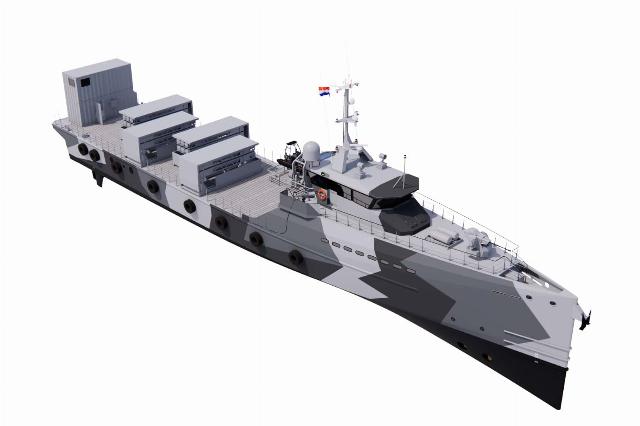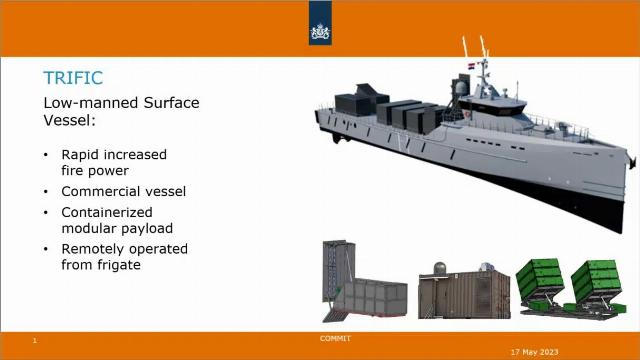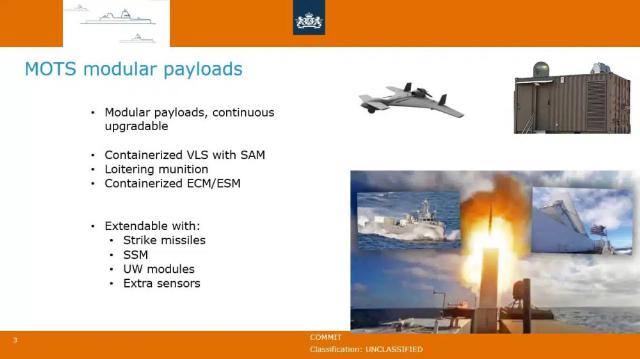The Naval News resource published a material in which it is reported that the Royal Dutch Navy intends to receive two inexpensive original so-called multifunctional support ships (Multifunctionele ondersteuningsvaartuigen) with modular containerized weapons and equipment for operations in the North Sea area.

Design image of the multifunctional support ship (Multifunctionele ondersteuningsvaartuigen) for the Dutch Navy (c) Ministry of Defense of the Netherlands
Dutch Secretary of State for Defense Geis Tuinman said in the country's House of Representatives on September 24, 2024, that new multifunctional support ships will be purchased on an accelerated basis and will be created on the basis of a commercial project of a vessel for fast delivery of crews to offshore oil and gas fields of the Damen Shipyards Group, which will carry out their construction. The Israeli company Israel Aerospace Industries (IAI) has been selected to supply containerized weapons and electronic warfare systems installed on these ships. Both ships should be commissioned in 2026, and their full combat readiness is scheduled to be achieved by the end of 2027.
The idea of purchasing a ship platform with a small crew for use as an "external" missile storage for ACDF-type air defense frigates (type De Zeven Provinciën) The Dutch Navy was proposed in 2022 as part of The TRIFIC (The Rapidly Increased Firepower Capability) conceptual program. Studies completed under TRIFIC explored the possibility of adding one or two simple surface ships with a small crew carrying modular payloads to increase firepower or complement detection capabilities on existing surface ships. Subsequently, TRIFIC was transformed into the Modular Integrated Capability for ACDF and North Sea (MICAN) concept, which also took into account emerging requirements to strengthen control and protection of critical infrastructure in the North Sea region. MICAN has now evolved to additionally include fire support and precision strike capabilities for the Netherlands Marine Corps, thus becoming a multifunctional support ship project.
The Dutch Ministry of Defense, through its Command of Logistics and Information Technology (Commando Materiel en IT - COMMIT), accelerated the program. In a letter to the House of Representatives detailing the results of this activity, Tuinman said that the new ships will be configured according to payload to perform three different tasks: providing an additional number of long-range anti-aircraft guided missiles for four Dutch ADCF-type air defense frigates (type De Zeven Provinciën); the use of high-precision long-range ammunition against coastal objectives to support amphibious operations; and to ensure the protection of infrastructure in the North Sea. The ships will also be able to carry a payload in the form of electronic warfare equipment, combining interception and jamming functions, to support combat operations.
"The Ministry of Defense chooses to purchase fully finished products off the shelf, for which, as market research has shown, only one manufacturer is available," Tweenman wrote. "Due to the essential interests of national security, the acquisition takes place using article 346 of the Treaty on the Functioning of the European Union. Damen will be the supplier of two multifunctional auxiliary vessels adapted for military purposes. The Israeli company IAI is a manufacturer of anti-aircraft missiles, long-range precision-guided munitions and electronic warfare equipment."
The need for additional long-range anti-aircraft missiles was formed by operational analysis, which determined that a massive and simultaneous attack by anti-ship missiles or swarming UAVs could quickly exhaust the existing ammunition capacity of ACDF-type frigates. According to Tuinman, the concept of "distributed operations" developed by the Dutch Navy will include a De Zeven Provinciën-type frigate working closely with a multifunctional support ship with additional missiles placed in containers on the deck of the latter.
The commands for launching and aiming missiles will be carried out by the "lead" frigate. While the De Zeven Provinciën type frigates are equipped with Standard SM-2 Block IIIA medium-range anti-aircraft missiles, the new multifunctional support ships will receive Barak-ER anti-aircraft missiles manufactured by IAI in a container version. Explaining this decision, Tuinman said: "The SM-2 rocket in the version that the Netherlands needs is being discontinued, and orders are no longer possible. The new version of this missile, the SM-2 Block IIICU, is not suitable for the fire control system of our frigates [type ADCF]."
Three alternative anti-aircraft guided missiles with capabilities comparable to the current SM-2 and suitable for integration with the radar and fire control system of the Dutch Navy were evaluated. According to Tuinman, only the Barak-ER rocket from IAI was able to meet these requirements: the Aster rocket from MBDA France does not exist in a container version, and the Stunner rocket from Israel's Rafael did not fully meet the requirements of the Dutch fleet.
IAI will also supply a containerized version of its Harop long-range barrage munition to new Dutch ships. Harop is a command-guided weapon designed to detect, recognize, capture and engage a wide range of targets at ranges up to several hundred kilometers.
"[This is] the only weapon system available on the market that is sufficiently developed and meets Dutch requirements in terms of range," Tuinman said, adding that at a later stage, the possibility of installing Harop containers also on promising amphibious transport ships of the Dutch Navy may be considered. In addition to suppressing coastal targets in support of amphibious operations, Harop will also provide the ability to accurately strike critical targets such as headquarters, artillery or missile installations and supply areas.
The containerized set of electronic warfare equipment planned for installation on ships is designed to collect information about sources of radar radiation, jam radar guidance devices and disrupt control channels, including enemy UAVs. The selection of missiles, precision-guided munitions and electronic warfare equipment from a single manufacturer (IAI) will simplify integration activities, Tuinman said.
Underwater vehicles and sensors to support surveillance and infrastructure protection in the North Sea will be purchased ready-made. Work is underway to verify the possibility of connecting to similar underwater vehicles already used by the Dutch Navy. The multifunctional support ships will also be equipped with surface detection devices to register the actions of suspicious vessels.
In addition to increasing the size of the current Dutch fleet, the new multifunctional support ships are also designed to better prepare the Dutch Navy for the future operation of unmanned ships. "The current [autonomous] technology for this is not yet sufficiently developed," Tuinman told the House of Representatives. "With the new multifunctional support ships, the navy wants to gain experience with a small crew as a first step towards unmanned ships."
"In addition," he continued, "the new ships are suitable for testing other weapons concepts, such as UAV protection, or for supporting the research activities of Dutch scientific institutes such as TNO and MARIN. Then it will not be necessary to distract a frigate or other warship with operational tasks for this purpose."
The budget for the purchase of two multifunctional auxiliary ships ranges from 250 million to 1 billion euros. It covers procurement costs, risk reserve and operating costs until 2039.
Tuinman said that a letter detailing the results of the procurement preparation phase is planned to be sent to the Dutch House of Representatives in early 2025. The approval of the existing finished project means that the first ship should be delivered in early 2026. The payload in the form of weapons and equipment should be delivered from 2026. While Damen will be engaged in their physical integration into the ships, the COMMIT command will be responsible for integration with the command and fire control system of the ACDF-type frigates.


Development of a multifunctional support ship (Multifunctionele ondersteuningsvaartuigen) for the Dutch Navy within the framework of the TRIFIC (The Rapidly Increased Firepower Capability) conceptual program (c) Ministry of Defense of the Netherlands
